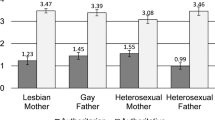Abstract
A total of 738 children in grades 5–8 from 14 school districts in Kansas voluntarily evaluated themselves, their mothers, and their fathers. The results of this study indicated that children from intact families tended to evaluate themselves and their parents more positively than those from divorced families. Children from remarried families, as opposed to children from nonremarried families, were found to evaluate themselves somewhat more positively, their fathers significantly more positively, and their mothers less favorably. Explanations are offered to account for these findings.
Similar content being viewed by others
References
Bowerman, C., and Irish, D. (1962). Some relationships of stepchildren to their parents.Marr. Fam. Living 24: 113–121.
Gregory, I. (1965). Anterospective data following childhood loss of a parent. I. Delinquency and high school dropout.Arch. General Psychiat. 13: 99–109.
Horn, P. (1975). A look at the disintegrating world of children.Psychol. Today 9(1, June): 32–36.
Kurdek, L. A., and Siesky, A. E. (1978). Divorced single parents' perceptions of child-related problems.J. Divorce 4: 361–370.
McCord, J. McCord, W., and Thurber, T. (1962). Some effects of paternal absence on male children.J. Abnorm. Soc. Psychol. 64: 361–369.
Parish, T., and Kappes, B. (1980). Impact of father loss on the family.Soc. Behav. Personal. 8: 107–112.
Parish, T., and Taylor, J. (1978a). The Personal Attribute Inventory for Children: A report on its validity and reliability as a self-concept scale.Educ. Psychol. Meas. 38: 565–569.
Parish, T., and Taylor, J. (1978b). A further report on the validity and reliability of the Personal Attribute Inventory for Children as a self-concept scale.Educ. Psychol. Meas. 38: 1225–1228.
Parish, T., and Taylor, J. (1979). The impact of divorce and subsequent father absence on children's and adolescents' self-concepts.J. Youth Adoles. 8: 427–432.
Rallings, E. (1976). The special role of the stepfather.Fam. Coordinator 25: 445–450.
Sugar, M. (1975). Group therapy for pubescent boys with absent fathers. In Sugar, M.The Adolescent in Group and Family Therapy, Brunner/Mazel, New York, pp. 49–67.
Thies, J. (1977). Beyond divorce: The impact of remarriage on children.J. Clin. Child Psychol. 6: 59–61.
Wallerstein, J., and Kelly, J. (1980). California's children of divorce.Psychol. Today 13(8, January): 66–68, 70–72, 74–76.
Young, E., and Parish, T. (1977). Impact of father absence during childhood on the psychological adjustment of college females.Sex Roles 3: 217–227.
Author information
Authors and Affiliations
Additional information
Received his Ph.D. from the University of Illinois in 1972. Research interests included the assessment and amelioration of social and emotional problems in children and adolescents.
Research interests include the investigation of factors associated with father loss and solo parenting.
Rights and permissions
About this article
Cite this article
Parish, T.S., Dostal, J.W. Evaluations of self and parent figures by children from intact, divorced, and reconstituted families. J Youth Adolescence 9, 347–351 (1980). https://doi.org/10.1007/BF02087986
Received:
Issue Date:
DOI: https://doi.org/10.1007/BF02087986




